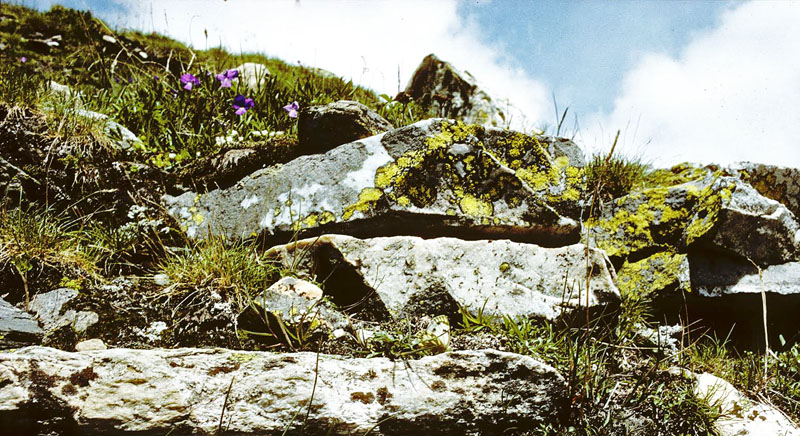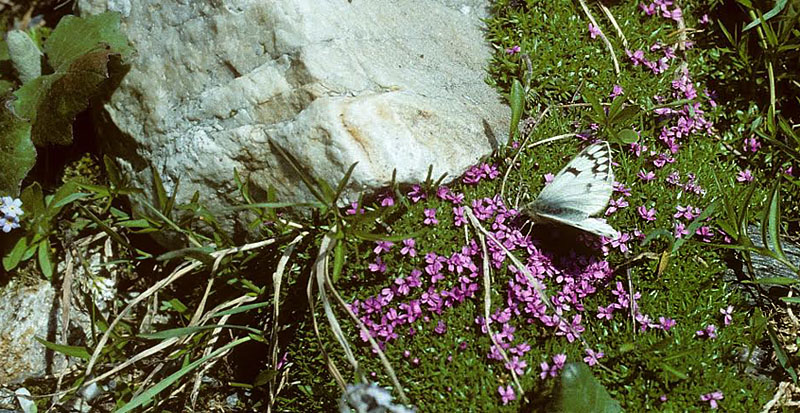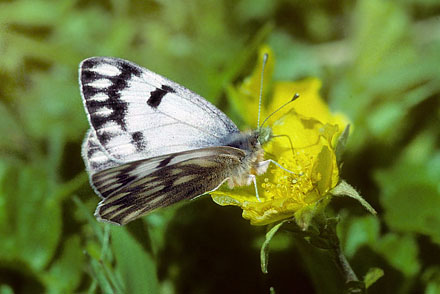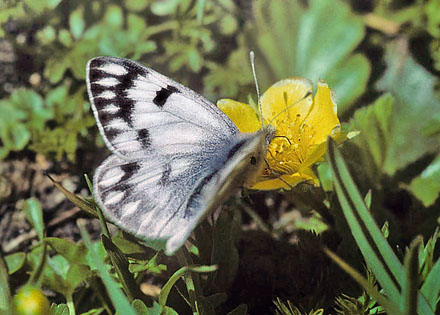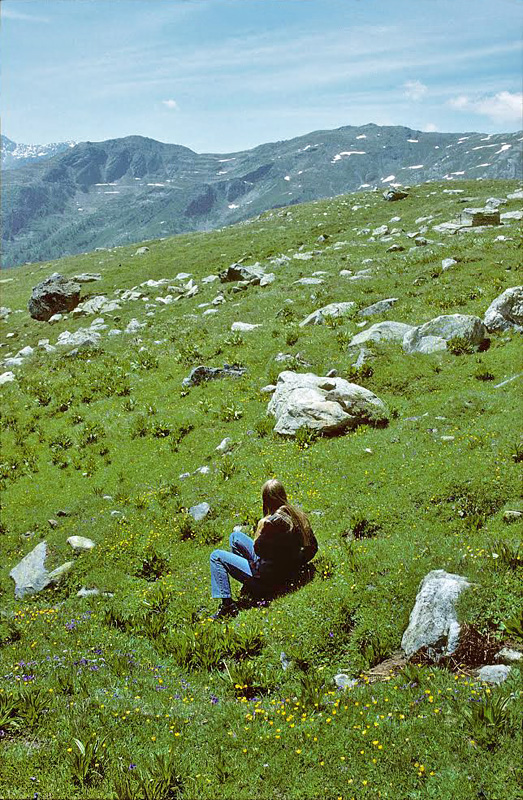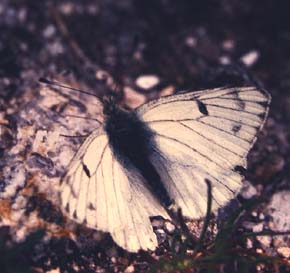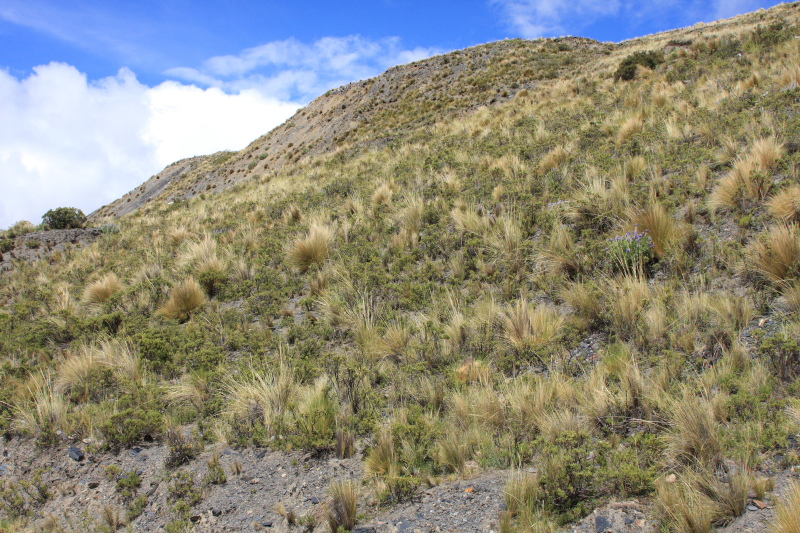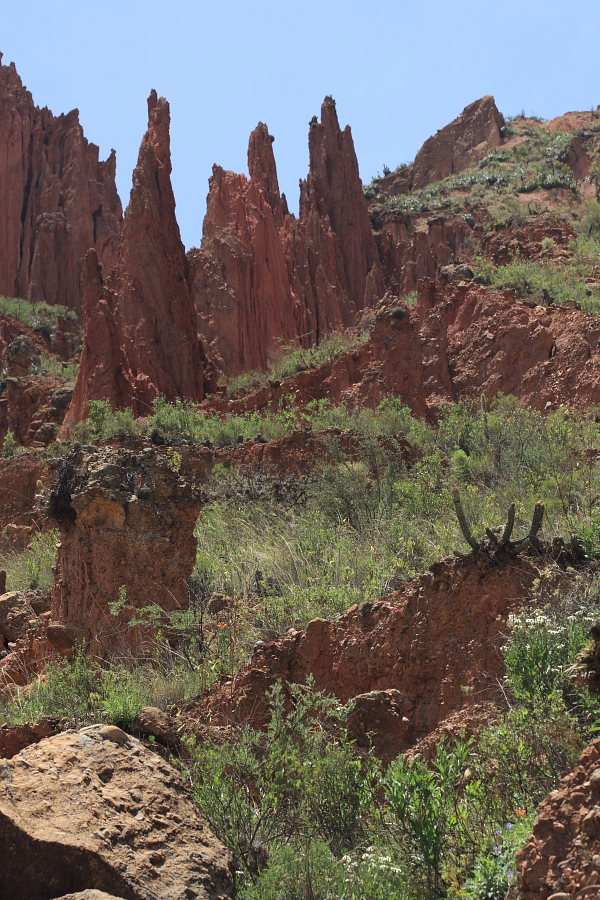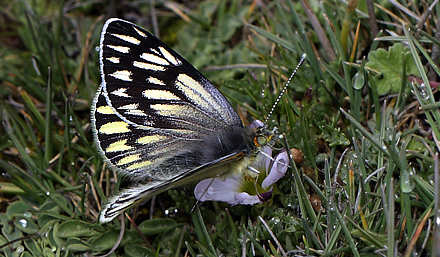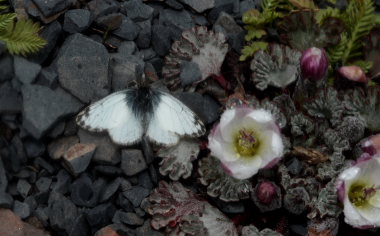Grønbroget Bjerghvidvinge
Pontia callidice
First update 15 november 2004
Last update 18 december 2017
| Lokalitet & Grønbroget Bjerghvidvinge, Pontia callidice. |
| Sct. Bernhard Passet & Val d'Aosta, Italien d. 27 juni 1996. Fotograf; Tom Nygard Kristensen |
Grønbroget Bjerghvidvinge, Pontia callidice (ESPER, 1800). Udseende: overside hvid. Hvor forvinge rodfelt er sort med mørke ribber over hele vingen, diskalcelle med kvadratisk sort diskalplet, i indre sømfelt med svage sorte pletter i celle 3 til 7. Og svage sorte pletter i apicalcelle. Bagvinge underside: lysegrøn med brede mørkegrønne tegninger langs ribber. Følehorn er sorte med hvide ringe. Vingefang: 53-60 mm. Levesteder: I stor højde på vegetationsløse alpine bjergskråninger og raviner, over trægrænsen i Østrig fra 1500 - 3400 m. som en af de højstlevende dagsommerfugle i Europa. Længere mod nord på den Sibiriske tundra i lavere højde langs stenrige flodbrinker. Flyvetid: I Sibirien fra sidst i juni til lidt ind i august. Værtsplante: æg lægges på Fjeld-Karse, Cardamine bellidifolia /C. alpina. Gemsekarse, Hutchinsia alpina. Hjørneklap, Erysimum helveticum og Pyrenæisk Reseda, Reseda glauca. Puppen overvinter under sten, ofte sammen med Alpebjørnespinder, Grammia quenselii larver. Udbredelse: Europa: de høje bjerge i Pyrenæerne og Alperne. Sibirien, Ural til Kirgisistan. NW Himalaya fra Chitral til Mussoorie, samt videre til Nepal over højde 4000 m. Tibet, Mongoliet til Altai. I Nordamerika fra Alaska til Californien flyver Western White, Pontia occidentalis (Reakirt, 1866) som er conspecific med P. callidice. En for Nordkalotten unik invasion af Sortåret Hvidvinge, Aporia crataegi med tusinde sommerfugle kom med en kraftig varm østlig varmefront fra Sibirien i juli 2004. Invasionen nåede store dele af det nordlige Finland og sporadiske fund i det nordlige Sverige i Absko og Alta i Norge. Med i invasionen var der en enkelt Grønbroget Bjerghvidvinge, Pontia callidice som blev fundet i Karigasniemi, finske Lappland juli 2004. På
dansk hedder den: Grønbroget
Bjerghvidvinge. På svensk: Alpvitfjäril. Lignende arter: På samme lokalitet flyver den lidt mindre Plettet Bjerghvidvinge, Euchloe simplonia. I lavere højde over det meste af Europa findes der krypto-arterne Grønbroget Hvidvinge, Pontia edusa & Vestlig Grønbroget Hvidvinge, Pontia daplidice som er mere marmoreret tegnet. GBIF: Global Biodiversity
Information Facility. íNaturalist.org |
Peak White, Pontia callidice. Lac Negre elevation 2400 m.h., Alps Maritimes, southern France. July 1988. Photographer; Lars Andersen
Peak White, Pontia callidice (Esper, 1800). Description: the upper side of the wings are white with black and gray. Forewing: are black at extreme bases of interspaces 1a and 1 and of cell; discocellulars marked with a quadrate black spot; a discal curved series of inwardly dentate spots, the spots in interspaces 1 and 2 generally reduced to a mere trace, often absent; an anterior terminal series of similar but more clearly defined spots at the apices of veins 3 to 7. Hindwing: green, an elongate oval yellowish-white spot in cell, followed beyond by complete curved series of discal and terminal yellowish-white, inwardly lanceolate spots. Antennae black, spotted with white, head fuscous grey, thorax blackish grey. Wingspan: 53-60 mm. Habitats: High altitude in alpine meadows, above the treeline. Further to the north on the tundra in lower altitude. Distribution: Europe: the high mountains of the Pyrenees and the Alps over elevation 2000 m. NW Himalayas over elevation 4000 m. from Chitral to Mussoorie. In Asia from Himalayas in China to the Altai. In German is called the: Alpen-Weißling. In French: Marbré des alpages. In Spanish: Blanquiverdosa alpina. In Dutch: Bergresedawitje. In Finnish: Alppisinappiperhonen. In Danish: Grønbroget Bjerghvidvinge. |
Alpebjørnespinder, Grammia quenseli. Borrasocohkka, Tornetrask, Lapland, Sverige d. 4 juli 2008. Fotograf; Daniel Dolfe
______________________________________________________
Heiner Ziegler site about Pontia callidice.
Butterflies from Lac Negre, 2354 m.h. Alps Maritimes, southern France July 1988.
______________________________________________________
Checkered White
Pontia protodice
Checkered White, Pontia protodice. Botanical garden, Salt Lake City, Utah, USA d. 17 july 2012. Photographer; Carsten Siems
Checkered White, Pontia protodice (Boisduval & Leconte, 1830). Description: the upper side of the wings are white with black and gray. The underside of the hindwings are marked with extensive yellow-brown veins, as the male may be weak character to almost white. The wingspan is 38-53 mm. Habitats: are open areas, including desert, plains, and disturbed areas. Virtually any disturbed dry open area such as vacant lots, railroads, airports, dry grassland, deserts, and cities are potential areas of inhabitation. In addition, populations may sometimes be found in sparsely wooded areas, grasslands, and meadows in the prairie and parkland regions, usually in areas without heavy shade. Distribution: is most commonly found in the southern parts on the United States along with some of the northern areas of Mexico. Occasionally the species can be found in the northern parts of the U.S. and southern Canada. |
______________________________________________________
Southern Chekered White
Tatochila autodice
Southern Checkered White, Tatochila autodice. The Valle de la Luna elev. 3500 m. La Paz, d. 25 january 2009. Photographer; Lars Andersen
Southern Chekered White, Tatochila autodice ernestae (Herrera, 1954). Description: the upper side of the wings are white with black and gray. The underside of the hindwings are marked with extensive yellow-brown veins, as the male may be weak character to almost white. The wingspan is 38-53 mm. Habitats: Hillsides with Puna grass and small shrubs and various succulents like cactus above the tree line from 3000 to 4500 meters altitude. Foodplants: are different Crucifers species. Distribution: is most commonly found in the mountain parts on Altiplano, Andes, Bolivia, Paraguay, Argentina and Chile. Genus Tatochila found in the Andes, has the same morphological characters as genus Pontia in North America. Asia and Europe. Should genus Tatochila changed to Pontia? |
The Valle de la Luna, La Paz, elev. 3500 m. Bolivia d. 25 january 2009. Photographer; Lars Andersen
______________________________________________________
Equatorial Montane White
Tatochila xanthodice
Equatorial Montane White, Tatochila xanthodice female. La Cumbre, elev. 4653 m. Yungas, La Paz, Bolivia d. 3 february 2012. Photographer; Lars Andersen
Equatorial Montane White, Tatochila xanthodice paucar (Lamas, 1981). Foodplants: are different Crucifers species. Distribution: is most commonly found in the mountain parts on Altiplano, Andes, Bolivia, Peru, Ecuador, Colombia and Venezuela. GBIF: Global Biodiversity
Information Facility. íNaturalist.org |
Andean Hillstar, Oreotrochilus estella. La Cumbre, La Paz, elev. 4300 m. d. 25 february 2009. Photographer; Lars Andersen
______________________________________________________
Small Bolivian Andean White
Pierphulia nysias
Small Bolivian Andean White, Pierphulia nysias. La Cumbre, elev. 4672 m. Yungas, La Paz, Bolivia d. 3 february 2012. Photographer: Lars Andersen
Here from South America in the eastern Andes up in the Cumbrepass, 4672 m. Yungas, Bolivia are the world's highest living white, the Small Bolivian Andean White, Pierphulia nysias (Weymer, 1890) which is about 20 mm in wingspan. Distribution: is endemic in the highest pass and peak in Eastern Cordillera Oriental, Andes, Yungas, Bolivia. |
______________________________________________________
Tilbage til DANMARK DAGSOMMERFUGLE
Home tilbage til forsiden
